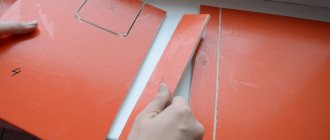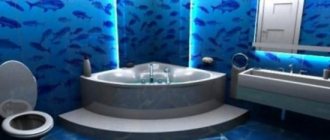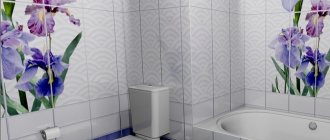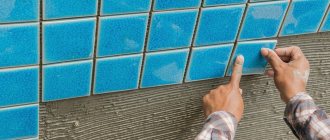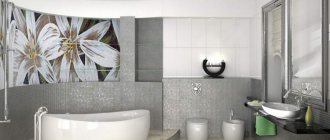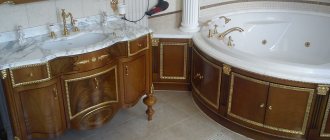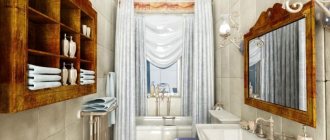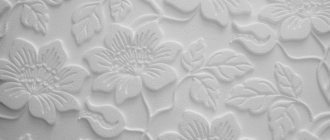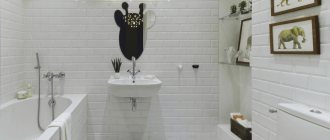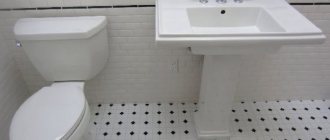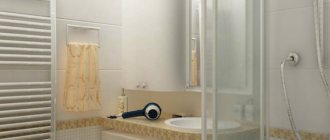Fans of original interior solutions will love the idea of making a bathroom with mirror tiles. This type of finishing expands the space And fills his light. It can be used to decorate the entire wall or part of it, arrange the elements in a chaotic order, alternating with ceramic products, or lay out a pattern. At the same time, it will not be inferior to traditional materials in terms of moisture resistance.
When choosing a mirror finish, you need to think about the style of the room in advance. Indicate which part of the walls will be finished, whether the ceiling will be used. Usually the wall behind the washbasin is chosen.
It is also useful to read: Flexible stone in the interior.
Advantages
Mirror surfaces allow you to hide small imperfections and, conversely, highlight the advantages of the room. Mirrors are an excellent option for a bathroom, since in most cases the area of such a room is very small, and with the help of mirrors you can visually enlarge the space. Mirrors installed at an angle can add depth to a room. In addition to all of the above, mirrors are excellent decorative elements.
In a mirror bath you need to follow a few simple rules:
- You should not place large objects near mirrors, as their size will be even larger in reflection;
- in order to maximize the visual enlargement of the bathroom with the help of mirrors, it is necessary to install glass panels so that the light source is reflected in them;
- The worst place to place mirror panels is the wall opposite the door and opposite the mirror.
It’s worth immediately noting that for wall decoration, not simple mirrors are used, but glass ones, and they come in several types.
- Mosaic. Glass mosaic has different shapes and shades. Using glass mosaics, you can lay out very beautiful patterns or even a whole picture on the wall.
- Mirror tiles. This option is considered more affordable. Mirror tiles are very easy to install; just use liquid nails or double-sided tape. The best choice would be beveled tiles; they have processed edges and therefore look very neat.
- Mirror cloth. To fasten such a canvas, you can only use liquid nails. It is very important to select those that will not harm the mirror coating. It is best to apply nails to the wall in the form of a grid, and after gluing, be sure to let the canvas sing along for several hours. To prevent moisture from getting under the mirror surface, all joints must be carefully treated with special silicone. Fastening in this way is only possible for walls without finishing.
You can also secure the mirror sheet using screws and special mechanical brackets.
Wall and ceiling finishing
In order to visually enlarge the space and improve the lighting in the bathroom, it is best to finish only one wall with mirror tiles or panels. A completely mirrored room will not look very nice and will make cleaning in this room questionable. Mirror surfaces are best combined with ceramic tiles. With the help of such finishing materials you can create a rather original and incredibly beautiful bathroom.
A mirrored ceiling for a bathroom with a small area is not the best option, as it will create the feeling of a well. But in a spacious bathroom, such a ceiling will look very beautiful, especially in combination with tiles on the walls.
If water gets on a mirror surface, stains remain on it. To avoid frequent cleaning, it is best to place the mirror wall away from water sources.
It is necessary to clean the mirror surface using special glass cleaners and a soft cloth that will not leave scratches.
Mirror shapes
When purchasing a mirror for the bathroom, it is advisable not only to think about its placement, but also to decide on the shape in advance. This point is often underestimated, considering it insignificant. Meanwhile, a well-chosen mirror shape can transform the entire room.
Rectangular mirrors
The most common option. A horizontal rectangular mirror visually increases the width of the space, while a vertical one increases the height. A long, narrow mirror enhances these effects. The same goes for sharp corners. The rounded corners of the mirror, on the contrary, soften the illusion of elongated space. Typically, a long rectangular mirror is installed horizontally above the washbasin. Vertical orientation is effective when two identical mirrors are placed in pairs.
Square
A wall mirror in the shape of a square visually balances the proportions of long rectangular rooms. To enhance the effect, you can place two square mirrors at a short distance from each other.
Round
A round shape can make a small bathroom seem more voluminous. But here it is important not to overdo it with the size: a round mirror that is too large will get out of the overall picture and create the opposite effect.
Oval
Oval-shaped mirrors can be placed according to the same rules as rectangular ones, but they only subtly change the perception of proportions.
Curly
Unconventional forms of mirrors are presented in the form of various distorted geometric shapes, stars, crescents, images of animals and fish. Such mirrors become a very bright, accent detail of the interior, so it is advisable to decorate the rest of the decor in a restrained manner.
Designer
Designer mirrors can be shaped or traditional in shape. Such products are given individuality by handmade decorative elements - rhinestone patterns, mosaics, paintings, stained glass. The decor is used both in the frame and on the surface of the mirrors. The design of the mirror can support the shades of the interior or, conversely, highlight it with a separate color to create a bright accent. In combination with the right lighting, designer products look very original.
Mirror tiles
A popular type of mirror decor, which is presented in the form of beveled tiles of square, round, rectangular and triangular shapes of different sizes. The edges of each product are beveled and polished. This treatment gives the tile finish volume and depth. Rectangular elements can be laid out vertically and horizontally, square elements can be laid out in the form of rhombuses. You can create an original ornament from round and triangular parts. Depending on the design idea, the tiles are laid closely or at some distance. Mirror tiles allow you to create panels from symmetrical and asymmetrical compositions, reflecting intended objects or their fragments in them.
Mirror for the bathroom (85+ photos)
A bathroom cannot exist without a mirror - a mandatory accessory that allows you to take care of your appearance. Modern designs, in addition to their main function, contribute to the decoration of the room, emphasizing the design idea. The stores offer a large selection of bathroom mirrors, but when choosing a product, you need to take into account not only aesthetic indicators, but also other characteristics, which we will talk about later.
Compositions
As mentioned earlier, a mirror has many functions, and among them are aesthetic ones. The glossy reflective surface makes the room light and airy, creating the illusion of expanding boundaries.
Try to use mirrors as an element of a unique interior design, use your imagination to realize the most daring ideas and non-standard solutions.
But we don’t recommend that you get too carried away: an excessive number of mirrors will make the room uncomfortable, and caring for a large area of glossy surface will be problematic.
Main selection criteria
Modern bathroom mirrors have many interpretations. They differ in many ways: sizes, shapes, materials, etc. Mirror panels consisting of an abstract collage look impressive, and huge structures from floor to ceiling perfectly enlarge the space and make it possible to contemplate oneself, as they say, in all its glory. So, let's look at what you need to consider first when choosing a mirror for the bathroom.
Shapes and sizes
If you want to significantly transform the interior in a modern style, you can resort to decorating one of the walls with mirror tiles, which can be square, triangular or radius. From individual elements you can create the most interesting mirrors of a special shape. Traditional products are presented in the following forms:
— Square – able to adjust the bathroom, especially if it has an elongated area; — Rectangular – the most popular option for panels that can be installed in different ways; - Oval - have smoothed corners, due to which they significantly decorate the interior, giving it a harmonious appearance; — Round - in addition to looking quite beautiful, they can visually expand the area.
As for sizes, there are no clear standards. The mirror must be selected in accordance with the dimensions of the room, as well as based on personal preferences. In addition to large wall panels, you can install a double-sided cosmetic mirror. One surface reflects in a normal image, and the other - in an enlarged one. Such mini-mirrors can be mounted to the wall, and the mechanism allows you to rotate the structure at any angle.
Materials
If we consider a mirror constructively, when choosing a model you need to pay attention to its three components: the base, the mirror layer and the frame.
Two materials are used as a base - chipboard and MDF. Mirrors with a chipboard base are less expensive, but they are more susceptible to moisture, which in a bathroom will lead to rapid deterioration of the original condition. It is better to opt for a more durable MDF base - although the product will cost a little more, but it will last longer. For the same reason, you should not choose chipboard cabinets with bathroom mirrors.
Hang it up
An extraordinary solution for a mirror in a wooden frame
In most cases, mirrors are directly attached to the wall. However, if you hang it on a visible cord or wire, then there will be a certain element of surprise that attracts attention. You can choose any material that is safe enough to hold a heavy mirror in a frame. Thick rope, reminiscent of a ship's rope, is suitable for maintaining a nautical theme, and steel wire will make the interior more modern and industrial.
Types of bathroom mirrors
As we have already said, there are quite a few options for designing reflective surfaces in the bathroom. Even the most ordinary mirror on the wall can become an original decorative element, dressed in a stylish frame. Modern mirrors have not gone unnoticed by technological progress, and today there are panels equipped with glass heating devices that prevent them from fogging, magnifying glasses, temperature sensors, radios and other bells and whistles. Let's look at the most popular of them.
Wall mirror
This concept combines two ways of installing a mirror. In the first case, we are talking about mirror panels with or without frames, which are mounted to the wall surface with special fasteners. They do not have structural additional elements, but due to the selected frames they look quite stylish. In the second option, the mirror is installed directly into the wall (“recessed” into the finishing material). Edging the mirror with tiles or moldings will add a special aesthetic.
Corner mirror
Placing a cabinet with a mirror in an empty corner is an excellent solution for small bathrooms. At the same time, the cabinet is long enough to accommodate hygiene items and does not take up much space.
Mirror with shelf
This model can rightfully be called the most popular, having passed the long test of time. The design is suitable for decorating any interior; it is convenient and practical, often complemented by decorative inserts and lighting. Some designs have additional hooks and stands, which makes them as convenient as possible. Moreover, the shelves themselves can be made of any material - the same mirror, glass, plastic. A mirror with additional design elements will allow you to place and keep personal hygiene products in perfect order.
Mirror in cabinet design
From the name it is already clear that it means the presence of a hanging cabinet, on the outside of the door of which there is a mirror. This design is usually attached above the washbasin, making it easy to get the necessary accessories while applying makeup or other procedures. The advantage is that cosmetics and personal care products remain hidden from prying eyes and do not create a feeling of clutter when laid out in plain sight. When choosing such a cabinet, you need to pay attention to its size - for small rooms, single-door designs with a shallow depth are preferable.
Illuminated mirror
This option can be called the most modern and, in general, expedient solution. There are several lighting options - it can be an LED strip running along the entire perimeter of the canvas, a traditional lamp directly above the mirror, or side lighting fixtures. In any case, such local lighting brings additional convenience during facial skin care or makeup, eliminates the need to use centralized lighting, and also creates a soft, romantic atmosphere while taking water treatments.
Heated glass mirror
A convenient modern model that features new technologies that help avoid the accumulation of fogging and condensation on the surface of the mirror. It doesn’t matter at all how high the temperature and humidity in the bathroom are. The mirror heating system is similar to analogues placed when organizing floor heating: on the back of the mirror panel there is a thin film with wires that are infrared heaters. In operating condition, the current passing through these wires can heat the surface in a short time. Mirrors are often complemented with lighting.
Mirrors and interior styles
An important aspect of choosing the right mirror is the correspondence of its external data to the style of the interior. The main role here is played by the shape of the canvas and the aesthetics of the frame.
For example, a luxurious classic bathroom is characterized by rectangular (oval) mirrors in luxurious frames made of wood or with forged elements. There may be gilding or fragments of artificial aging.
For the Provence style, it is difficult to come up with anything better than a mirror in an antique wooden frame, decorated with carved decor. Sometimes the surface of the mirror itself has coating defects, which makes the design as believable as possible. The most successful shape is round, but others may be present. Mirror panels placed on forged stands look beautiful.
The idea of minimalism in interiors does not imply luxury - order, rigor and laconic design reign here. Mirrors may not have frames at all and surprise with their unexpected shapes. The maximum number of mirror surfaces is welcome to make the room seem spacious and free. High-tech interiors will be successfully complemented by illuminated and heated mirrors, and for a loft-style bathroom you can choose the design of a floor mirror with a rough frame.
Design with mirror tiles
There are several options for how to use mirror tiles in a bathroom with design photos:
- Finish the entire wall using pieces of identical size. For example, square, triangular or rectangular elements.
- Combination with ceramic tiles. Mirror elements alternate with simple ones in a chaotic manner or form some kind of pattern.
- Large squares arranged diagonally. They add style and chic to the interior.
- Mosaic mirror tiles in the bathroom. As a rule, it consists of small squares. They are used as elements with a reflective surface, as well as their alternation with ceramics.
- Finishing adjacent surfaces. For example, a ceiling with a wall or two walls. This design option uses materials of different colors or textures. For example, for the ceiling you take a regular mirror, and for the wall - with a pattern.
Mix and match
The arrangement of round mirrors resembles soap bubbles in a bubble bath
Collect mirrors of different sizes and/or styles and hang them on the wall to create a gallery-like look. But choose only mirrors that will complement each other. And place them all on one wall, otherwise the bathroom may turn into a funhouse.
Types of mirror tiles
Tiles with a reflective surface are produced in 3 ways, from different materials.
- Glass. In fact, this is the most ordinary mirror, just small in size.
- Polished metal. The reflective properties of this material are worse, but the cost is lower.
- Polystyrene. The main advantage of this material is the price. The front side is covered with paint containing metal particles. The reflection quality is lower, but this material is easier to cut. There is often a self-adhesive film on the back side, which makes installation easier.
The most common shape of finishing materials is a square or rectangle, the size varies from 9 to 30 cm . However, you can order tiles of any size and shape. Elements in the form of rhombuses and triangles are also popular.
Based on texture, the following types of tiles can be distinguished:
- Perfectly smooth, without relief. During installation, the joints are practically invisible. You can create a mirror canvas on the wall or ceiling.
- Metal imitation. The color of such tiles is most often silver, gold or bronze. In this case, finishing materials may even have traces of corrosion.
- Tinted. Most often, slightly darkened elements are chosen for decoration. The color palette ranges from smoky gray to pink and bright red shades.
- With an image. The image is applied to the decorative elements using a laser or sandblasting method.
- With facet, i.e. with a beveled edge. Such mirror tiles in the bathroom interior give the room beautiful reflections due to the refraction of light rays. It is also easy to install.
- With relief – allows you to create three-dimensional design elements in the interior.
- Mosaics are small mirror squares that can be used to create a pattern or completely lay out part of a wall.
It is also useful to read: Decor in Provence style.
Features of wall and ceiling decoration
To get a beautiful interior without defects, you need to carefully prepare the surface - it must be perfectly flat . The slightest roughness will lead to the reflection being distorted and the entire interior ruined.
Before you begin installing tiles on the wall or ceiling, you need to lay out a pattern on the floor in order to pre-select the tiles according to size and shape.
Before installation, the surface of the wall or ceiling must be leveled , primed and treated with an antiseptic . The drawing must be thought out in advance. Ideally, when selecting materials, you should strive to ensure that the tiles do not have to be cut. After all, then there will be a processed edge, and this will worsen the quality of the material. But if trimming could not be avoided, you need to use a glass cutter .
There are several ways to install mirror tiles - the choice depends on the surface. For a suspended ceiling, screws , and for walls and floors, silicone-based glue liquid nails or a mixture of sand and bitumen are used (but only if the backing is opaque).
The choice of tile arrangement and finishing style depends, in addition to simply taste preferences, on the tasks being solved in the interior. For example:
- For a small bathroom, a ceiling with a reflective surface is relevant. He seems taller, the space is expanding. But it is important not to overdo it: a completely mirrored ceiling creates the effect of an inverted space. Therefore, a part of the surface is selected for finishing - the center or perimeter.
- If in a large space one of the walls is made completely mirrored, then the room may seem empty and cold. Therefore, you need to be careful with the finishing and carefully consider the design.
Mirrors with shelves
A mirror with a built-in shelf is a common model for the bathroom. It combines stylish design and practical benefits. There is always a need for additional space to accommodate the necessary small items and hygiene items, and an extra shelf will help solve this problem.
Modern manufacturers are ready to offer many models of various configurations: shelves made of glass, chrome, wood, plastic, open and closed structures.
This solution is especially relevant for a modest area and modern style of bathroom interior.
Caring for mirror tiles
It is not enough to simply renovate your bathroom and enjoy the results. Mirror tiles require maintenance - although it is not complicated and will not cause much trouble. with a damp cloth from time to time . Dirt can be easily removed using glass and mirror cleaners . You can also clean mirrors with a solution of warm water and vinegar .
Under no circumstances should you use hard brushes , metal sponges, or materials with an abrasive surface. This will lead to scratches remaining on the surface and the appearance will be hopelessly damaged.
To prevent the surface from attracting dust, you can use antistatic agents.
Backlight
You can update the simplest, standard mirror by adding lamps to it or creating hidden lighting. Of course, you can buy a mirror with lamps included, or you can organize the lighting yourself.
Hidden lighting with a soft glow will make the atmosphere relaxing and cozy. A mirror with lamps will decorate the bathroom and is ideal for morning routines and applying makeup. This is especially important for rooms where there is no natural light.
Advantages and disadvantages of this decor
Like any finishing materials, mirror tiles have their advantages and disadvantages.
- durability;
- fire resistance - such tiles do not burn ;
- wide range - design possibilities are limited only by imagination;
- environmental friendliness - no hazardous impurities are used in production;
- allows you to visually expand small rooms;
- ease of care;
- appearance.
- there must be good ventilation in the room, otherwise the tiles will fade and become stained;
- Care must be taken during transportation as the material is very fragile;
- price: this design is not the cheapest pleasure.
Kitchen realities
In the kitchen, as a rule, only the apron is made mirrored. For these purposes, use tiles measuring 10x10 centimeters. Thanks to repeated fragmentation of the image, even the most ordinary kitchen interior “comes to life”.
Mirrored “apron” in the kitchen - perhaps not very practical, but elegant
You can also alternate square and rectangular tiles in one row.
Mirror tiles for the kitchen are easy to clean - any glass cleaning solution will return it to its original cleanliness.
Mirrored bathroom: nuances
Mirror finishes or mirrored details look harmonious in any bathroom. In minimalist interiors with matte concrete-like tiles and classic ones with glossy marble-like tiles. And the mirror finish is combined with chrome parts (faucets, handles, heated towel rail, etc.). But there are nuances.
Mirrored bathroom with gold decor
The number of mirror elements is determined by the area of the bathroom
It seems that the smaller the bathroom, the more mirror elements it should have. In fact, it's the other way around. The smaller the bathroom, the simpler the interior. For example, one accent mirror wall or mirrored shelves in a small bathroom is enough. If the bathroom is large, then the following options are possible: a mirrored ceiling, a large mirrored cabinet, mirrored mosaic, etc.
Mirrored bathroom with green tiles
Mirror elements “work” with the area when used in moderation
Mirror surfaces increase space only when used in moderation. For example, a completely mirrored ceiling in a small bathroom will create a well-like effect where the light is just above you.
Good example:
A glossy ceiling in a spacious and bright bathroom with a minimum of details increases the space.
Bathroom with glossy ceiling
Bad example:
A glossy ceiling in a dark small bathroom with an abundance of details (tiles of different shapes and designs, contrasting colors) makes the space even smaller.
Dark bathroom with glossy ceiling
Moisture resistance for mirror finishes is important
Acrylic mirrors with a reflective amalgam surface are suitable for decorating a bathroom. Amalgam, or silver oxide, resists temperature changes and is moisture-resistant, unlike the aluminum layer, which darkens and stains.
Typically, mirror surfaces for the bathroom are additionally coated with several protective layers (in addition to amalgam), which prevent moisture from getting inside.
Mirror wall in the bathroom example
The entire interior depends on the location of the mirror surfaces
It is better not to place large objects (high floor pencil cases, washing machine, etc.) near mirrors - in reflection their size will be even larger.
The worst place to place mirror panels is the wall opposite the door and opposite the mirror. Your own reflection from the doors can be scary, and mirrors opposite each other create mirrored corridors.
Mirrored bathroom layout example
Functions
- Combined with another piece of furniture. For example, an ideal way to add functionality to a small bathroom is to use a cabinet with a mirror.
- Freestanding.
- Decorative. Usually these are small mirrors with unusual frames. They are used only in stylistic decisions.
Of course, these are not all types of mirrors. Every year more and more types appear. For example, with the function of heating, rotation or movement.
Finishing a mirrored bathroom: walls and ceiling
Mirror tiles for bathroom walls
Mirror tiles with bevel for the pros
We have already talked in detail about the bevel on the mirror. In short, beveled tiles are more resistant to moisture and temperature changes than a simple mirror due to the glass processing technique. The downside is that it is difficult to install. Cut it correctly, prepare the walls/ceiling, lay it without large seams (otherwise it won’t look as beautiful as in the picture) - and the work doesn’t end there. This requires construction skills, or even better, a professional.
Important:
It is better not to mount mirror panels opposite the mirror, otherwise endless mirror corridors will appear.
Bathroom with mirror tiles with bevel photo
Bathroom with beveled mirror tiles example
Mirror mosaic in the bathroom for a bright accent
Glass mosaic will look good in a small bathroom only as an accent. If you decorate the entire room (or several walls) this way, it will be greatly narrowed due to its diversity. Most often, mirror mosaic is the only bright accent in the bathroom. For example, among matte gray tiles or walls.
Advice:
Mirror surfaces are best combined with ceramic tiles.
Bathroom with mirror mosaic tiles on the wall
Bathroom with mirror mosaic on the wall photo
Mirror panel in the bathroom for a dark and small bathroom
A decorative technique that solves many practical problems. Hang a panel on one of the walls of a narrow bathroom - the space will become wider. Install a panel in front of the lamps - there will be twice as many light sources.
Advice:
A vertical mirror panel will elongate the ceiling, and horizontal panels will make the space wider.
Bathroom with a mirror panel on the wall photo
Bathroom with a mirror panel on the wall photo
Mirror ceiling in the bathroom
Pros:
The mirrored ceiling is neutral in relation to the interior, so it can be combined with any decor. Duplicates lighting, making the darkest space lighter and the smallest space larger.
Minuses:
Despite the neutrality, such a ceiling requires elaboration of details in the interior (finishing, plumbing, prints, etc.) because all this will continue in the ceiling. Uneven tiles or an old faucet will stand out even more.
Important:
There is a misconception that a mirrored ceiling in a small, narrow or cramped bathroom is a 100% way to increase space. In fact, it will create a block effect in a small bathroom when the light comes only from above. Therefore, a mirror ceiling is a good option for large bathrooms.
Lighting
High-quality reflection in the mirror is obtained only in good lighting. Overhead light from a lamp or spot LEDs may not be enough, especially in a large bathroom. Therefore, in addition to the factory lighting, mirrors are often illuminated additionally. The mirror above the washbasin and dressing table is usually illuminated with small sconce lamps, which are mounted on the sides (the light is directed upward) or from above. The light source can also be installed opposite.
All mirror surfaces reflect incident light and enhance illumination.
